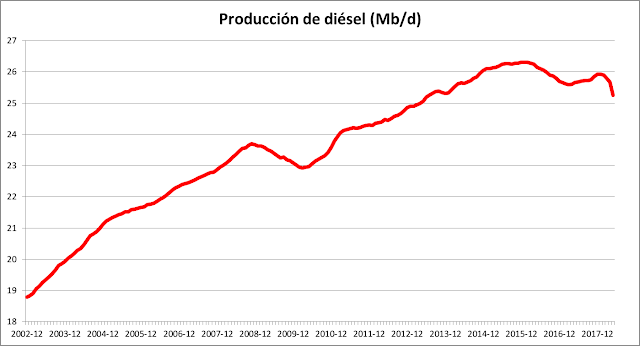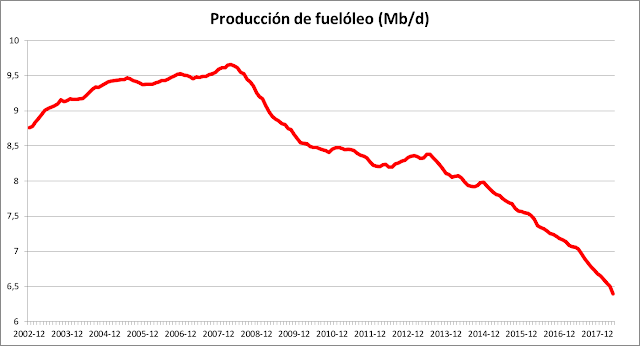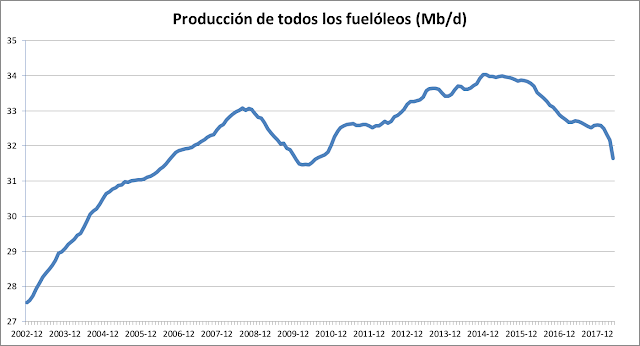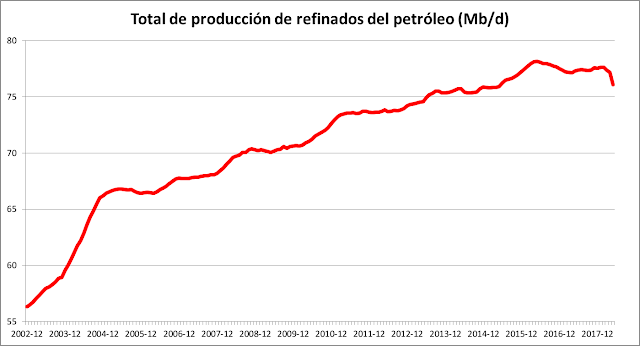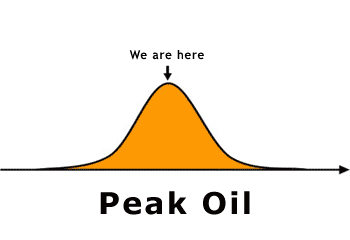
At the beginning, the idea of “peak oil” seemed to be relatively uncomplicated: we would climb from one side and then go down the other side. But no, the story turned out to be devilishly complex. For one thing, there is no such a thing as “oil” intended as a combustible liquid — there are tens, perhaps hundreds, of varieties of the stuff: light, heavy, sour, sweet, shale, tight, dumbbell, and more. And each variety has its story, its peculiarities, its trajectory over time. Eventually, all the oil curves have to end to zero but, in the meantime, there is a lot of wiggling up and down that continues to take us by surprise. Mostly, we didn’t realize how rabidly the system would deny the physical reality of depletion, much preferring to “legislate scarcity” on the basis of pollution.
Here, Antonio Turiel writes a fascinating post telling us how the peak is coming “from below,” affecting first the heavy fraction of crude oil: diesel and fuel oil. That’s already causing enormous problems for the world’s transportation system, as well as for the owners of diesel cars, and the situation will become much more difficult in the near future. The light fraction, the one that produces gasoline, seems to be still immune from peaking, but that will come, too.(U.B.)
The Peak of Diesel Fuel: 2018 edition.
As in the previous two posts, we will use the database of the Joint Oil Data Initiative (JODI). This database provides information about most of the world’s oil and refined products, but not all of them. The countries not included are countries with serious internal problems and a great lack of transparency, either because of wars or because they are very tight dictatorships. For this reason, the figures that I will show are around 10% lower than they should be if they were representing the whole world. However, given the characteristics of the excluded countries, it is most likely that their data did not change the observed trends, only the total amounts.
As seen in the graph, the year 2015 marked the maximum so far. There had not been such a marked drop in production since the crisis of 2008-2009, but in the case of the fall of 2015 we find that 1) there has not been a serious global economic recession;2) the descent is lasting longer and 3) the levels of diesel production show no sign of recovery. Although it is still a little early to ensure that the peak of diesel has occurred, stagnation – even falling – is starting to drag on for too long to be ignored.
Looking at the data of JODI, two other very interesting things are observed. On the one hand, if one analyzes the production of all the fuel oil that is not diesel (fuel oil) it is found that its production has been in decline for years.
As the graph shows, since 2007 (and therefore before the official start of the economic crisis) the production of fuel oils is in decline and it seems to be a perfectly consolidated trend. The diehard economicist interpretation is to consider that there is simply no demand for these fuels (which, although of the same family, are heavier than diesel). When oil is refined, it is subjected to a process called cracking, in which the long molecular chains present in the oil are broken (by means of heat and other processes) and then the molecules are separated by their different properties of fluidity and density. The fact is that if you have made changes in the refineries to crack more oil molecules and get other lighter products (and that is why less heavy fuel oil is produced), those molecules that used to go to heavy fuel oil now go to other products. By logic, taking into account the added value of fuels with longer molecules, it is normal that these heavy fuel oils are undergoing cracking, especially to generate diesel and possibly more kerosene for airplanes and eventually more gasoline. We must not forget that from 2010 the fracking in the USA began to take off, flooding the market with light oil, which is not easy to refine to make diesel. It is therefore quite likely that the refineries have adapted to convert an increasing amount of heavy fuel oil into light fuel oil (diesel). It reinforces this idea that, if we add the volumes of the two previous graphs we have, there is a certain compensation for the trends of diesel production, increasing until 2015, and the long-term trend of decrease of the rest of the fuel oils.
This figure shows that, after the 2008-2009 slump, it has been very hard to raise the total production of fuel oils, which peaked in 2014 and have remained there for almost a year; and at the moment it is suffering a resounding fall (about 2,5 Mb/d from the levels of 2014).
This last observation is quite relevant because if, as you can guess, the industry is cracking less heavy fuel oil to ensure that the production of diesel does not go down too much, the rapid fall of heavy fuel oil will quickly drag down the diesel production. In fact, the graph shows that, after falling in 2015 and 2016, in 2017, it was possible to stabilize the production of all fuel oils, but it is also seen that in recent months there was a quite rapid fall.
Surely, in this shortage, we can start noting the absence of some 2.5 Mb/d of conventional oil (more versatile for refining and therefore more suitable for the production of fuel oil), as we were told by the International Energy Agency in his last annual report. This explains the urgency to get rid of the diesel that has lately shaken the chancelleries of Europe: they hide behind real environmental problems (which have always troubled diesel, but which were always given less than a hoot) to try to make a quick adaptation to a situation of scarcity. A shortage that can be brutal, since no prevention was performed for a situation that has long been seen coming.
The followers of that religion called economic liberalism will insist with all their strength that what is being observed here is a peak of demand, that old argumentative fallacy that does not agree with the data (who can think that people are stopping to consume oil because they want? Maybe because they have better alternatives? Which ones?). They will argue that there is a lower demand for diesel and that this is why production stagnates and that the production of fuel oils drops because, as they are more polluting fuels, the new environmental regulations do not allow their use. It’s a bit of the old problem of who came first, the chicken or the egg. With regard to the fact that the demand for diesel does not increase, prices have a considerable influence: this is how shortages are regulated in a market economy. And, as for the environmental reasons, the production of heavy gas oil has been dropping from 2007, when there was not as much regulatory interest as there seems to be now. There is one aspect of the new regulations that I think is interesting to highlight here: from 2020 onwards, all ships will have to use fuel with a lower sulfur content. Since, typically, the large freighters use very heavy fuel oils, that requirement, they say, makes one fear that a shortage of diesel will occur. In fact, from what we have discussed in this post, what seems to be happening is that heavy fuel oils are declining very fast and ships will have no choice but to switch to diesel. That this is going to cause problems of diesel shortage is more than evident. It is an imminent problem, even more than the peaks in oil prices that, according to what the IEA announces, will appear by 2025.
The second of the interesting things that the JODI data shows us is how the volume produced of all petroleum products has evolved.
The volume produced has been able to continue increasing during these years thanks to the energy subsidy that the US is giving to the world by means of fracking. However, fracking oil only serves to make gasoline and that is why the diesel problem remains. But you can also note how the end of the graph above shows the same trend in the production of diesel, with a drop of more than 2 Mb/d. What does that mean? That the contribution of fracking to the whole volume is also hitting the ceiling, it does not get any higher. It is a further indication that we are already reaching the peak oil of all petroleum liquids.
That is why, dear reader, when you are told that the taxes on your diesel car will be raised in a brutal way, now you know why. Because it is preferred to adjust these imbalances with a mechanism that seems to be a market (although this is actually less free and more adjusted) rather than telling the truth. The fact is that, from now on, what can be expected is a real persecution against cars with an internal combustion engine (gasoline will be next, a few years after diesel). Do not say that you were not notified (and I was not even the first to do it in this blog). And if it does not seem right, maybe what you should do is to demand that your representatives explain the truth.
Regards
AMT
Note: this post was translated from Spanish using Google Translate, which did a pretty good job, necessitating only some retouches — although the result is still somewhat “Spanish-sounding” even in English! One problem is the use of the Spanish terms “gasoil” and “diésel” which may not mean the same thing as they do in English (in Italy, btw, diesel fuel is always termed “gasolio”). But these two terms indicate a very similar entity, even though maybe not identical. So, I reworked Turiel’s text a little in order to use only the term “diesel”.



